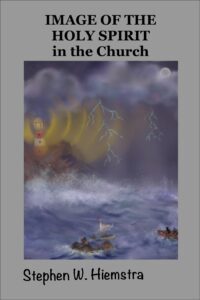Casting John’s Vision for the Church

But the Helper, the Holy Spirit, whom the Father will send in my name,
he will teach you all things and bring to your remembrance
all that I have said to you.
(John 14:26)
By Stephen W. Hiemstra
If the Holy Spirit instigated external events in church history for Luke and the Holy Spirit inspired internal faith and community life for Paul, the Holy Spirit worked miraculously through custom, covenants, and visions for John in forming the church. John gives us genderless titles for God—The I am, the Alpha and Omega, and the Almighty—that express God’s power, majesty, and divine agency (Rev 1:8). These titles are not specifically used to describe the Holy Spirit, but clearly they address God in the person of the Holy Spirit most aptly. John casts the vision of the New Testament church.
The Holy Spirit in John’s Gospel
John’s Gospel uses the term Holy Spirit only three times. In the first context, John the Baptist identifies Jesus as the one who baptizes with his Holy Spirit (John 1:33). In the second, John gives an outline of Holy Spirit’s job description: “But the Helper, the Holy Spirit, whom the Father will send in my name, he will teach you all things and bring to your remembrance all that I have said to you.” (John 14:26) In the final context, Jesus commissions the disciples as apostles—“As the Father has sent me, even so I am sending you”—and grants them the Holy Spirit (John 20:21-22). In the Greek, an apostle is literally one who is sent.
The first and the final use of the Holy Spirit is in divine commissioning. The second use is interesting to us here because it provides an interpretative key. Jesus’ teaching is not forgotten because the task of the Holy Spirit, the Paracletos (παράκλητος), is specifically to teach and help the disciples remember Jesus’ teaching (John 14:26). This is a very personal job description for the Holy Spirit, something not provided by other biblical authors. The Holy Spirit is not just an impersonal force or invisible agent (breath of God) sent by God—Everyone knows the name and nudge of their tutor.
The Holy Spirit in Revelation
The term Holy Spirit does not appear in Revelation but the book refers to the Spirit and to angels repeatedly in the context of offering advice to the church. John uses two specific phrases to identify seven churches in the second and third chapters of Revelation. First, he says: “To the angel of the church in” (Rev 2:1, 2:8, 2:12, 2:18, and 3:1, 3:7, 3:14 ). Closely following this phrase, he repeats: “hear what the Spirit says to the churches” (Rev 2:7, 2:11,2:17, 2:29, and 3:6, 3:13, 3:22). The churches mentioned are: Ephesus, Smyrna, Pergamum, Thyatira, Sardis, Philadelphia, and Laodicea, respectively. What follows after this stylistic language is prophecy offering both praise and rebuke to churches in Asia Minor. This series of exhortations appears to be the Paraclete mentioned in John’s Gospel at work in the daily life of the churches.
Another clear prophecy to the church is:
“Then the voice that I had heard from heaven spoke to me again, saying, go, take the scroll that is open in the hand of the angel who is standing on the sea and on the land. So I went to the angel and told him to give me the little scroll. And he said to me, take and eat it; it will make your stomach bitter, but in your mouth it will be sweet as honey. And I took the little scroll from the hand of the angel and ate it. It was sweet as honey in my mouth, but when I had eaten it my stomach was made bitter. And I was told, you must again prophesy about many peoples and nations and languages and kings.” (Rev 10:8-11)
The voice from heaven sounds like “Spirit of God was hovering” (Gen 1:2), which is the avian metaphor for the Holy Spirit. In this vision, prophecy is shown to be illuminating (or interpreting) scripture, which is the Old Testament role of the prophet. That is, drawing attention to God’s covenantal obligations rather than providing new revelation (Ferguson 1997, 214). This vision is emphatic because it references two sources of authority: The voice from heaven and a giant angel with one foot on land and the other on the sea.
The Apostle John in Revelation makes allusion to a vast array of scripture, stories, and covenants, more than any other book in the New Testament. A recurring theme is, however, to usher us into the throne room of God—the ultimate appeal to authority—and to observe proper worship:
“Let us rejoice and exult and give him the glory, for the marriage of the Lamb has come, and his Bride has made herself ready; it was granted her to clothe herself with fine linen, bright and pur”—for the fine linen is the righteous deeds of the saints.” (Rev 19:7-8)
Most curious is to see “fine linen” compared with “the righteous deeds of the saints.” There is a sense in this abrupt comparison that the usual focus in high and mighty worship on fancy clothes, as in a kingly coronation, is being almost ridiculed in casual comparison here. Perhaps, proper worship requires a pure heart and righteous deeds, not fancy linen.
Casting John’s Vision for the Church
Also see:
The Face of God in the Parables
The Who Question
Preface to a Life in Tension
Other ways to engage online:
Author site: http://www.StephenWHiemstra.net
Publisher site: http://www.T2Pneuma.com
Newsletter at: https://bit.ly/East25 , Signup
The post Casting John’s Vision for the Church appeared first on T2Pneuma.net.



